If you’re planning to camp near Antelope Canyon, you’ll want practical, location-based advice to make the trip smooth and safe. You can’t stay overnight inside the slot canyons, but there are nearby campgrounds, dispersed sites on Glen Canyon, and riverfront spots that offer solitude and dramatic views. I’ll outline the best spots, permit rules, and packing tips so you can pick the option that fits your gear and tolerance for remoteness.
Where Antelope Canyon Is and How to Get There
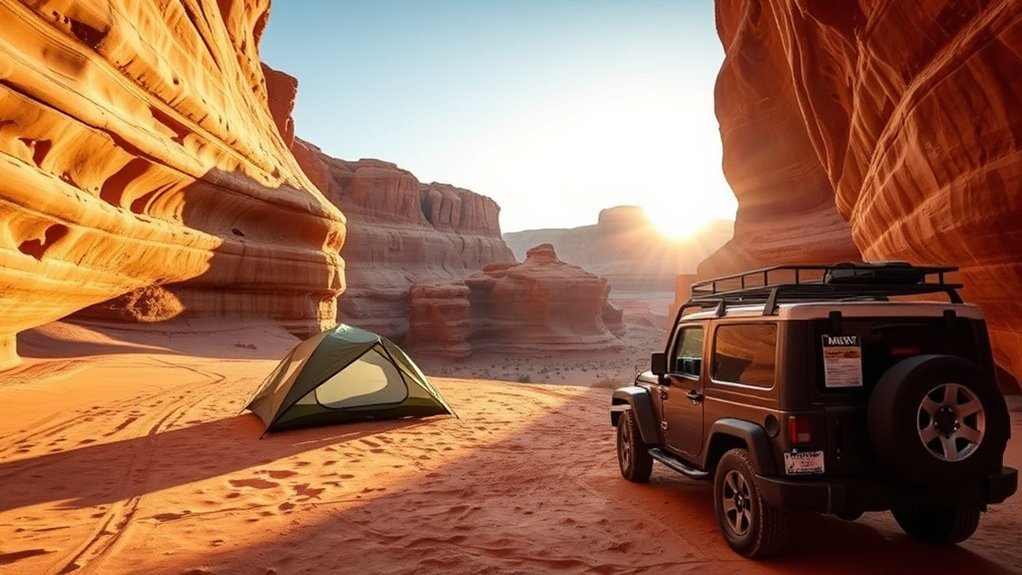
If you’re heading to Antelope Canyon, you’ll find it in Lake Powell Navajo Tribal Park about ten minutes east of Page, Arizona — a quick drive from town but roughly four-and-a-half hours from Phoenix. When you visit Antelope Canyon, you’ll notice two distinct experiences: Upper Antelope Canyon at ground level and Lower Antelope Canyon, which asks you to climb stairs and ladders. Reservations with authorized Navajo guides are mandatory, so plan ahead and book through approved tour operators; self-guided hikes aren’t allowed. Tours usually last up to two hours including travel time, so arrive at least 15 minutes early. Pack water, sun protection, and good shoes. Getting there is straightforward, but timing and guides are nonnegotiable.
Can You Camp Inside Antelope Canyon?
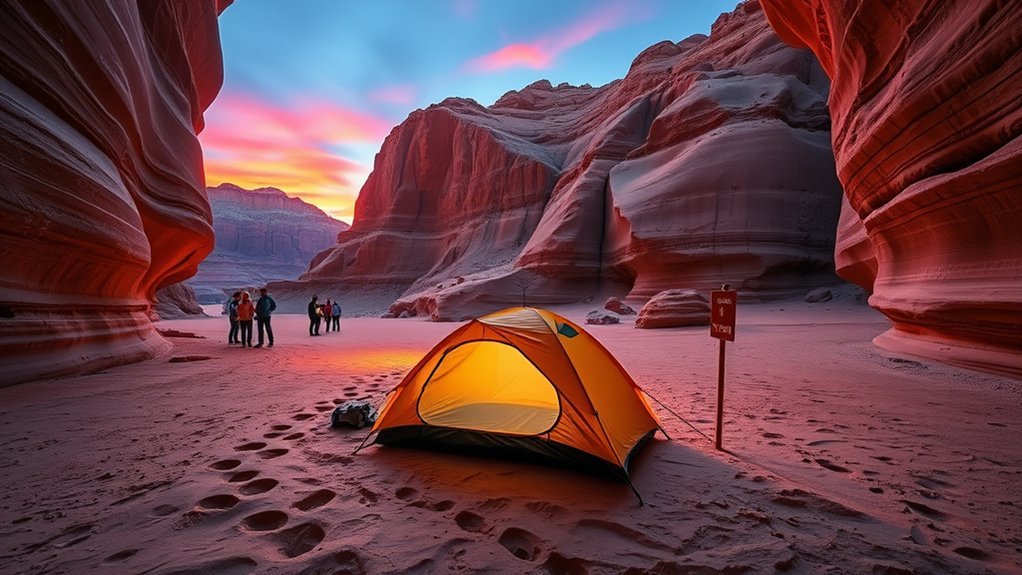
You can’t camp inside Antelope Canyon — access is by guided tour only and overnight stays are prohibited for safety and conservation. Instead, plan to stay at nearby campgrounds or dispersed sites within about 30 minutes, or arrange a backcountry permit in Glen Canyon National Recreation Area if you want a more remote experience. I’ll outline practical nearby options and permit steps so you can pick the best overnight plan.
Camping Inside Canyon?
Although the canyon’s slot walls invite a sense of solitude and wonder, you can’t camp inside Antelope Canyon — it’s a protected Navajo Nation site that only allows entry on guided tours, and overnight stays are expressly prohibited. You’ll walk those narrow, light-dappled corridors during daylight hours only; guided tour rules and Navajo Nation regulations don’t permit tents, sleeping bags, or lingering after close. Practically, that means planning ahead: book a guided tour for access, then secure lodging elsewhere. Treat the canyon as a day-only experience and respect cultural and safety restrictions. If you’re itching for a night under the stars, consider permitted backcountry camping nearby with proper permits and fees rather than attempting camping inside canyon.
Nearby Overnight Options
Because camping inside Antelope Canyon is prohibited, plan to stay nearby and treat the canyon as a day trip: guided tours cover the slot canyons during daylight only, so you’ll find overnight options at Glen Canyon National Recreation Area (backcountry camping with a $14-per-night permit), at walk-up campgrounds like Lees Ferry and Beehives, or at dispersed sites along Lake Powell where you’ll need to pack out all waste; for a different kind of riverside night, consider floating to the free 6 Mile and 8 Mile camps along the Colorado River, which are reachable only by boat. You can camp near Antelope at established spots or opt for primitive backcountry camping permits. Lees Ferry and Beehives are first-come, walk-up. Lake Powell Campground areas offer dispersed sites away from marinas, so bring water, a permit if needed, and pack out everything to protect the shoreline.
Best Campgrounds Near Page, AZ
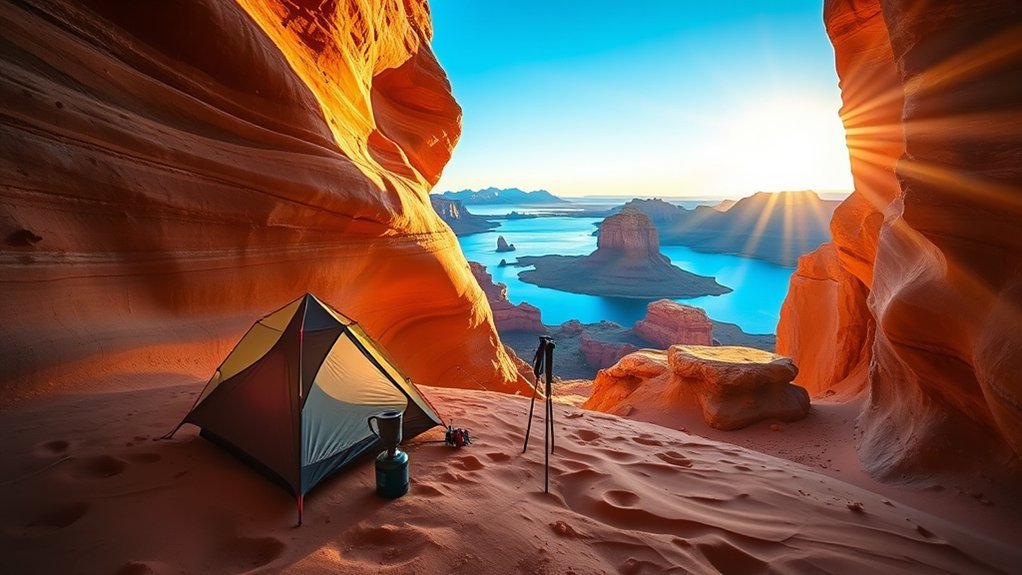
You’ll find both National Park Service campgrounds and private RV parks within easy reach of Antelope Canyon, so pick the setup that fits your rig and comfort level. Lees Ferry and Beehives offer walk-up tent and small-RV sites at budget rates, while Roam America and Wahweap provide full hookups and modern amenities for longer stays. If you’re floating the Colorado, consider the free river-access sites, or plan a dispersed spot at Lone Rock or Alstrom Point if you’ve got a 4WD and want more solitude.
NPS Campgrounds Nearby
If you want a no-frills, reliable base for exploring Antelope Canyon and Glen Canyon, head to the two nearby NPS campgrounds—Lees Ferry and Beehives—which operate on a true walk-up, first-come-first-served basis. You’ll find Beehives Campground small and intimate with six sites for $14 per night; it accepts self-contained units only and has no hookups. Lees Ferry Campground gives you more options—54 sites at $20 per night and an RV dump station—still without hookups. Both sit within easy reach of Glen Canyon National Recreation Area vistas and make practical bases for canyon trips. Try arriving on a Tuesday for the best chance at a spot. Pack water, shade, and flexibility; these places move fast.
RV Parks & Hookups
An RV stay near Page puts you close to Lake Powell and Antelope Canyon while keeping creature comforts within reach — many parks offer full hookups, restrooms, and dump stations so you can focus on the scenery instead of logistics. You’ll find modern rv park options that make the camping experience easy and enjoyable: Roam America RV Resort has new facilities and reliable full hookups; Wahweap RV & Campground sits on the waterfront with marina access and 139 sites; Antelope Point RV Park gives quick access to Antelope Canyon with 104 sites; Page Lake Powell Campground adds gym and indoor pool perks, but book ahead. Practical tips: arrive with reservations, level your rig, verify hookup types, and use dump stations before departure.
- Roam America RV Resort: modern amenities
- Wahweap: lakeside marina access
- Antelope Point: quick canyon access
- Page Lake Powell: pool, gym, book early
RV Parks and Full-Hookup Options
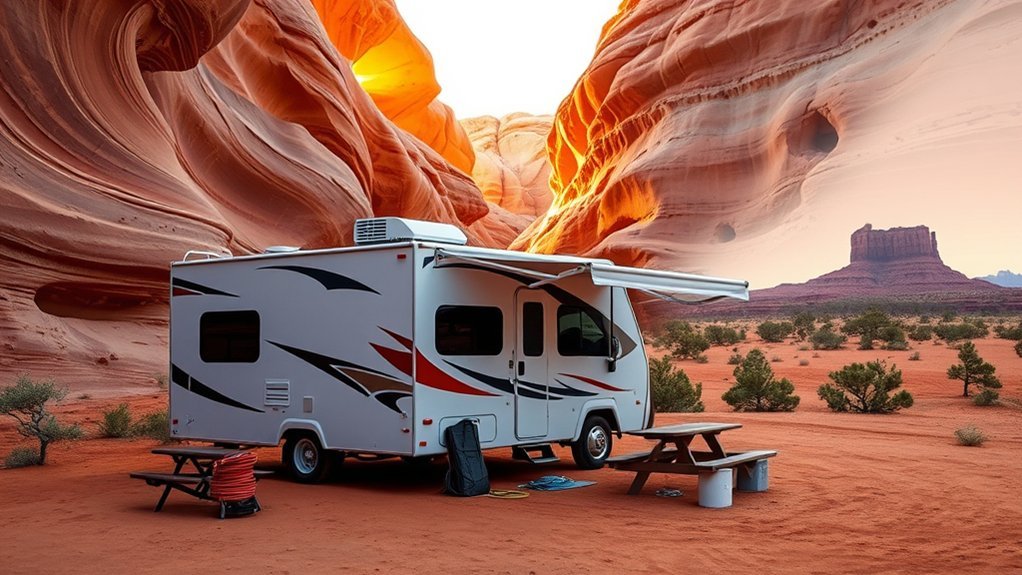
When you roll into the Page area with an RV, you’ll find several full‑hookup options that keep things simple and comfortable while you explore Antelope Canyon and Lake Powell. You’ll spot RV parks like Roam America RV Resort and Wahweap RV & Campground, which offers 139 full hookup sites and marina access. Antelope Point RV Park’s 104 sites sit under 15 minutes from town, and Page Lake Powell Campground is popular enough that reservations are often necessary. Expect restrooms, showers, and easy access to beaches and tour pick‑ups. Pick a site that matches your needs—slip into a waterfront spot for sunset views or choose a sheltered site for quiet nights—and book early in spring through fall to avoid disappointment.
Dispersed and Backcountry Camping in Glen Canyon
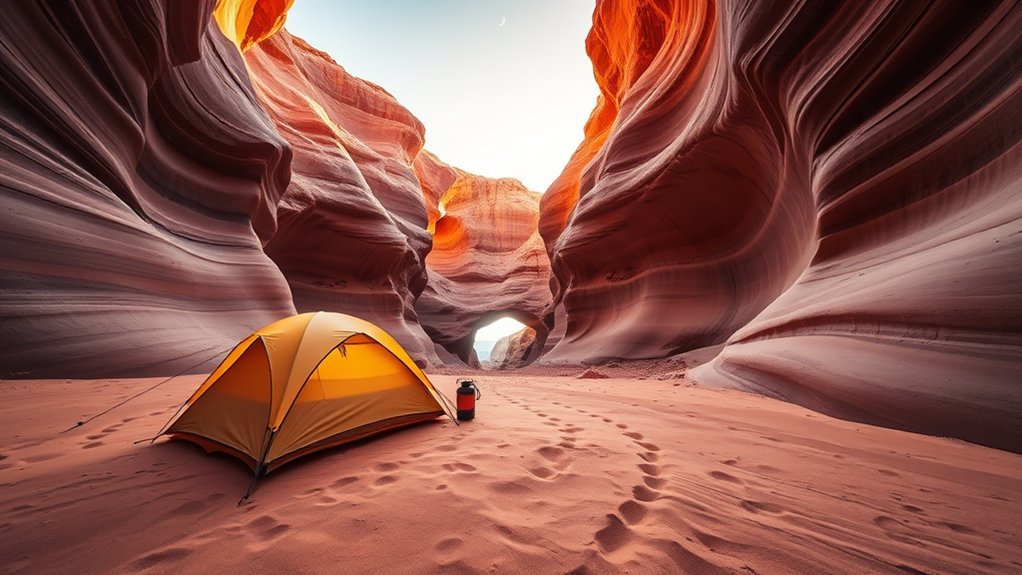
Choose dispersed camping in Glen Canyon and you’ll trade campground comforts for wide, quiet beaches, dramatic cliffside overlooks, and real solitude—but you’ll also need to come prepared. You’ll pay a $14 fee and get a permit on arrival, then pick a site away from marinas, picnic areas, and trailheads. Bring all drinking water since no water available at dispersed sites, and be ready for rough roads—Alstrom Point often needs 4WD.
- Expect no facilities: pack everything you need.
- Popular spots: Lone Rock Beach (fee applies) and remote cliff overlooks.
- Pets allowed, but pack out all waste, including pet waste.
- Leave no trace: pack out all waste and minimize campfire impact.
Beach Camping on Lake Powell and Lone Rock
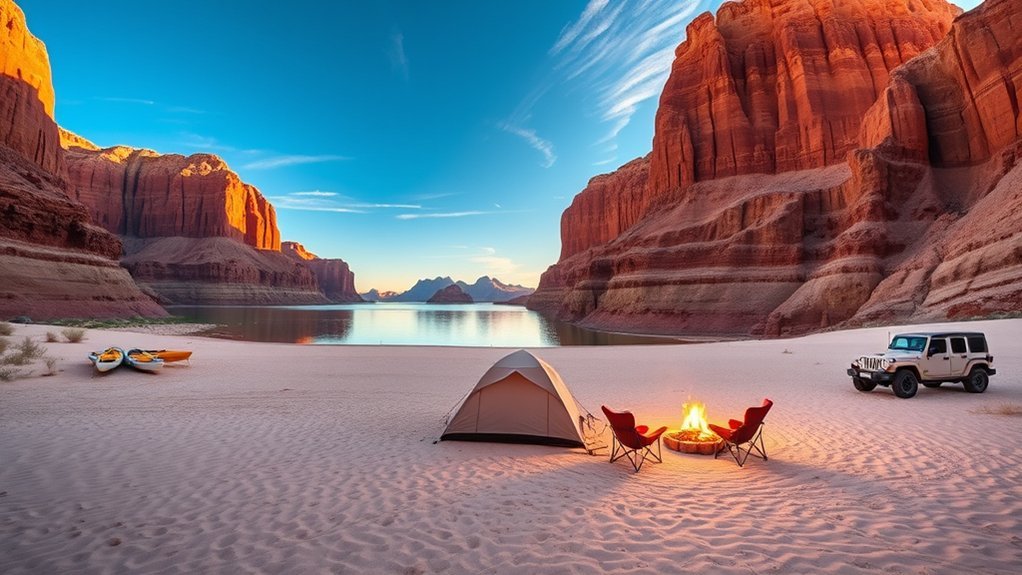
You’ll drive right onto Lone Rock Beach for sandy, car-accessible camping, though some spots need 4WD to reach. Pay the $14 nightly fee, pack out all trash, and be prepared for no restrooms or hookups. Arrive early in peak season to claim a waterfront site and enjoy easy swimming, kayaking, and those big Lake Powell views.
Lone Rock Beach Access
If you’re after shoreline camping with big-water views, Lone Rock Beach on Lake Powell delivers: for $14 a night you can drive right onto the sandy shore, pitch a tent or park an RV, and fall asleep to the sound of water lapping at the rocks. You’ll arrive easily by car, unload close to your site, and set up for stunning sunsets and immediate access to water activities like swimming, kayaking, and paddleboarding. There are no developed facilities, so plan and pack accordingly. Pets are welcome, but you must manage waste. Essentials to remember:
- Bring plenty of drinking water and shade
- Pack out all trash and human waste
- Secure gear for wind and sun
- Have a paddlecraft or swim plan for safety
Beach Camping Rules
When camping on Lone Rock or elsewhere along Lake Powell, follow the shore rules closely so you leave the water and landscape as you found them: pay the $14 nightly fee where required, camp only outside marked marinas and off tribal lands, and pack out every bit of trash and human waste to protect water quality. Choose a firm sandy spot for beach camping and set up away from high-tide lines; tents and RVs both work, but sandy access favors high-clearance vehicles. Treat dispersed camping like low-impact backcountry travel—leave no trace, bury nothing, and carry out waste. Bring ample drinking water; there’s no potable supply at Lone Rock or other dispersed sites. Keep soaps and fuel off the shore to protect the lake.
Campsite Facilities & Fees
Packing out trash and planning for limited services go hand-in-hand with choosing a beach site, so it’s worth knowing what facilities and fees you’ll encounter at Lone Rock and other Lake Powell shore camps. You pay $14 per night for beachfront access and vehicle parking, trading full hookups for sand, sunsets, and direct water access. Facilities are minimal—expect fire pits but no potable water—so bring plenty of drinking water and secure your trash and pet waste.
- Arrive early: Lone Rock Beach fills fast in peak season.
- Pack it out: all trash and pet waste to protect water quality.
- Water: none provided; carry what you need for cooking and drinking.
- Cost: $14/night for dispersed beach camping at Lake Powell.
These practical choices keep the shoreline pristine.
Free Campsites on the Colorado River
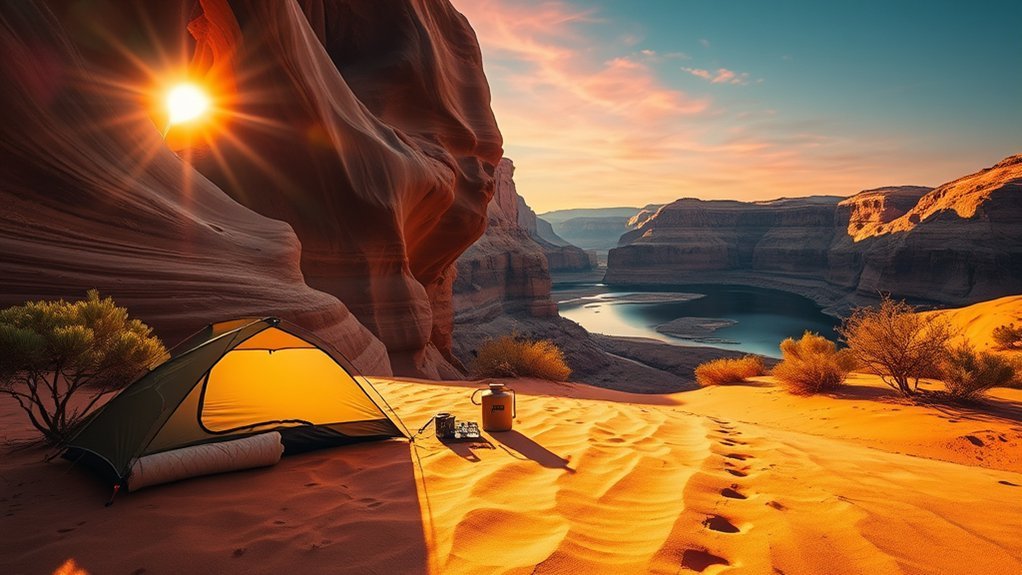
Although they’re tucked along the river and out of reach by vehicle, the three free campsites at 8 Mile, 6 Mile, and Ferry Swale give you a rare, budget-friendly way to sleep under the canyon sky—each site offers a fire pit and a basic restroom but no potable water, so you’ll need to bring everything you’ll drink and cook with while planning to arrive by boat or kayak. You’ll float into simple clearings where starlight and canyon walls frame your camp; 8 Mile sits closest to Horseshoe Bend, so expect dramatic morning light. Pack a reliable water supply, a stove, and waterproof bags, and plan campsite chores around tides and currents. Leave no trace, secure food from wildlife, and set an early departure plan.
Permits, Fees, and Reservation Tips
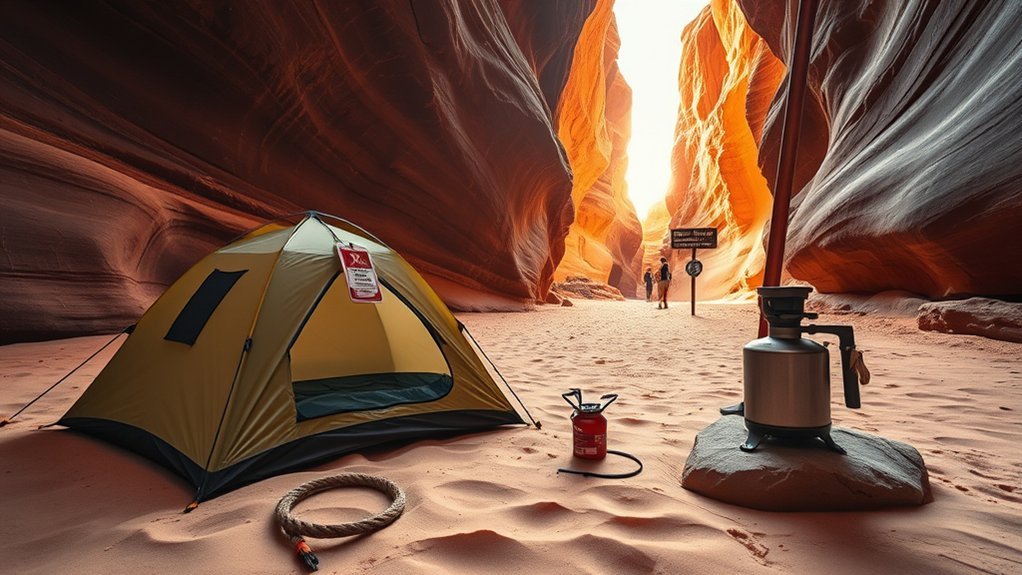
Because every visit to Antelope Canyon is guided, you’ll need to plan for permits, tour fees, and advance reservations—think of them as part of the trip, not an afterthought. You’ll book tours that include an $8 entry permit fee; expect Upper Canyon tours around $50–$90 and Lower Canyon from $40–$80 for deluxe options. Reservations are essential, especially March–October, since slots fill months ahead. You should arrive 15 minutes early for check-in and confirm any extra fees with your operator.
Plan ahead—guided tours require permits, fees (about $8 plus $40–$90), reservations, and prompt check-in.
- Book tours well in advance to secure dates.
- Factor permit and guide fees into your budget.
- Choose Upper vs. Lower based on price and experience.
- Confirm meeting point, parking, and cancellation policy.
What to Pack for Camping Near Antelope Canyon
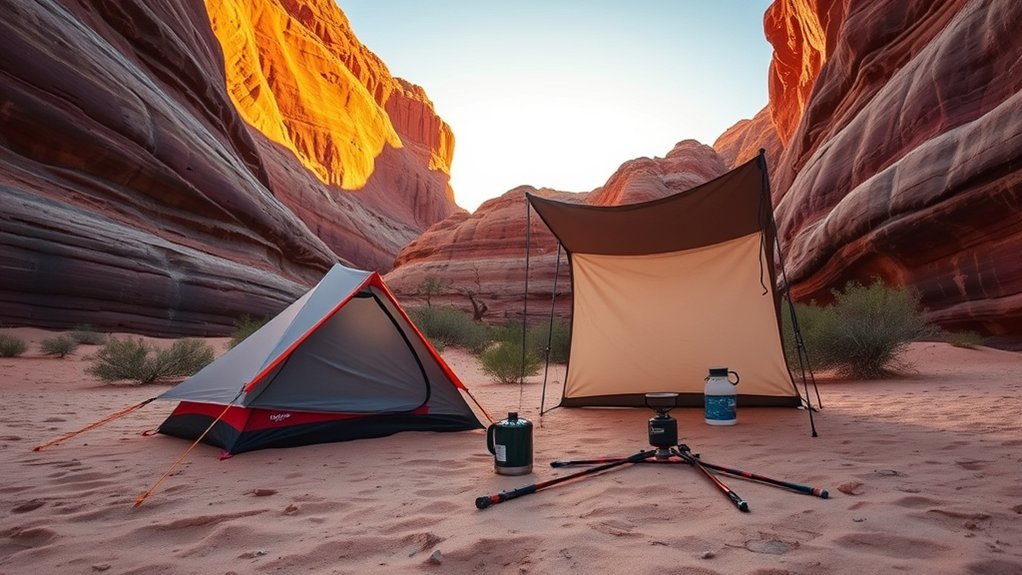
Think essentials: you’ll want a sturdy tent or RV gear, warm sleeping bags, and a compact cooking setup, plus plenty of food and water since many nearby sites lack potable water and trash service. For what to pack for camping near Antelope Canyon, include sun protection—sunscreen, a wide-brimmed hat, sunglasses—and layered clothing for cool nights and hot days. Bring durable closed-toe shoes for slot canyon approaches and any kayaking gear if you plan to reach free campsites by water. Prioritize hydration: carry more water than you think and portable purification only as backup. Pack a reliable headlamp, basic first-aid, and a charged camera with spare batteries and memory cards to capture canyon light; leave tripods and selfie sticks at home.
Leave No Trace and Local Regulations
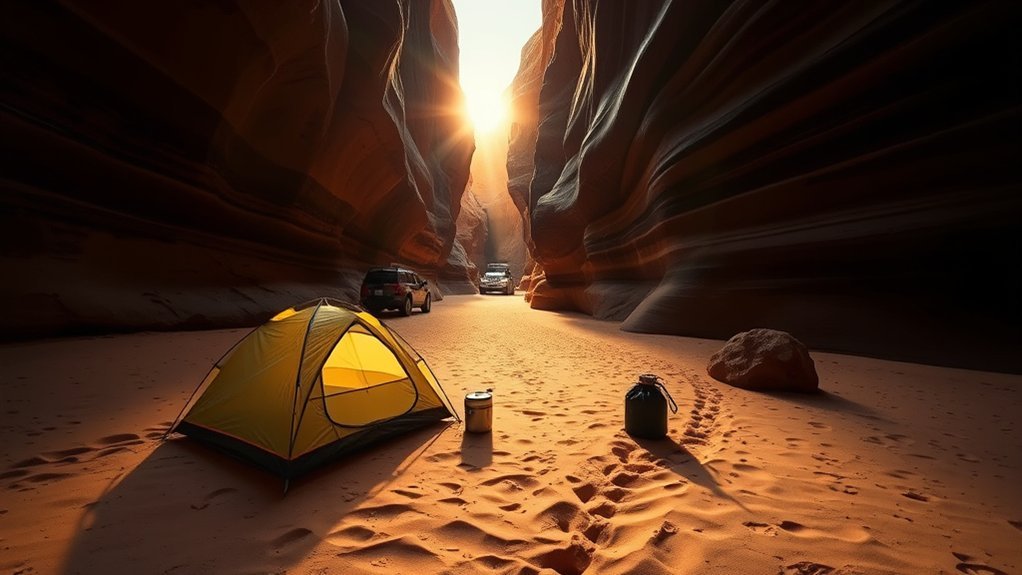
After you’ve packed the gear for a comfortable trip, respect for the land and local rules should guide where and how you camp. You won’t camp inside Antelope Canyon — it’s protected and accessible only by guided tour — so plan around permitted sites and nearby backcountry camping in Glen Canyon National Recreation Area. Follow leave no trace practices to keep sandstone and water pristine.
Respect the land: camp only at permitted sites near Glen Canyon, follow Leave No Trace, and avoid Antelope Canyon.
- Pack out all trash and human waste; Lake Powell’s water quality depends on it.
- Obtain required permits and pay the $14 fee for dispersed camping where allowed.
- Check local regulations for tribal lands surrounding the canyon before arriving.
- Use established sites when possible; minimize impact by avoiding vegetation and cultural sites.
These steps keep the landscape wild for everyone.
Frequently Asked Questions
How to Choose a Backcountry Campsite?
Pick a campsite selection by evaluating terrain assessment for flat, safe ground, staying a quarter-mile from facilities, scouting water sources responsibly, accounting for wildlife considerations, using existing fire rings, packing out waste, and obtaining the required permit.
How to Avoid Crowds at Antelope Canyon?
Picture the canyon whispering solitude—you’ll avoid crowds by booking off peak visits, choosing sunrise exploration, taking alternative routes like Lower Canyon, and joining small guided tours; arrive early, book weekdays, and move deliberately for intimacy.
What Is the Difference Between Camping and Backcountry Camping?
Camping is staying at developed sites with amenities; backcountry camping is remote, self-reliant. You’ll pack camping essentials and backcountry gear, follow campsite etiquette, practice outdoor safety, and plan navigation, water, permits, and Leave No Trace.
Can You Bring Backpacks Into Antelope Canyon?
About 90% of visitors report lighter loads, so no — you can’t bring backpacks into Antelope Canyon. Follow canyon regulations: carry only photography equipment or a small pouch, heed safety precautions, and minimize gear per backpack restrictions.
Conclusion
You can’t camp inside Antelope Canyon, but you can still sleep under its skies: pitch at Lees Ferry or Beehives, park your RV at nearby full‑hookup sites, or seek quiet dispersed spots in Glen Canyon. Bring water, maps, permits, and common sense; respect flood warnings, fragile slot walls, and wildlife. Pack light, pack well, leave no trace—tread softly, camp responsibly, enjoy the silence, and wake ready to watch canyon light shift and shimmer.

